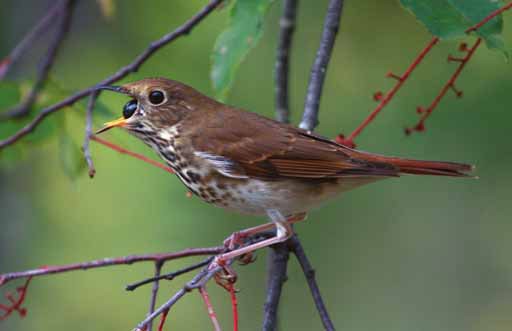Health-conscious humans have long known that brightly colored vegetables are healthier than blandly colored ones; turns out, songbirds also pay attention to color when it comes to their food.
To fuel their migration, songbirds choose to feed upon certain brightly colored berries, in part because those berries offer protection against oxidative stress that occurs during long flights and can lead to inflammation and disease. That is the conclusion drawn by a medicinal plant expert and two wildlife biologists from the University of Rhode Island (URI) who studied the feeding patterns of migratory birds stopping over on Block Island, off the coast of Rhode Island.
“The birds and the berries evolved together,” said Navindra Seeram, who heads up the Bioactive Botanical Research Laboratory at URI. “With their colorful fruits, the plants are advertising their berries to the birds, and the birds have learned that they can get the best bang for their buck by eating those colorful berries.”
“The colorful fruits have a different set of beneficial compounds than something like garlic, which is white, said Seeram. “Plant pigments, or polyphenols, are there for antioxidation purposes. The compounds protect the plant from oxidation, which can damage tissues and cells. And the pigments are the same compounds found in the colorful fruits, from strawberries and blueberries to red grapes and raspberries.”
The study was conducted by observing the feeding patterns of migratory birds and then collecting batches of the 12 different kinds of berries growing on Block Island for an analysis of their antioxidant levels. The researchers said that the birds preferred eating berries from the arrowwood viburnum, which contains more antioxidants and plant pigments than any of the 11 other berries.
According to Seeram’s research partners, biologist Scott McWilliams and graduate student Jessica Bolser, the plants benefit from the relationship with the birds by having their seeds dispersed by the birds.
“It’s the way plants ensure their survival,” McWilliams said. “Birds eat the berries, digest them, and defecate the seeds over wide areas. Meanwhile, the birds are attracted to the berries because of their rich color, which we believe is a plant’s response to constant exposure to the sun and other stresses. Berry color could be a plant’s way of fighting oxidative stress, and some of these same plant antioxidants may help birds combat the oxidative stress that occurs during their long migratory flights. It’s a partnership that benefits the plant and bird.”
McWilliams’s interest in this plantberry relationship was raised when he observed that many bird species were eating berries during migration even though the birds usually eat insects or seeds during the rest of the year. This research is the first demonstration that birds prefer certain wild fruits with more antioxidants during migration.
The researchers added that people should follow the lead of migratory birds and eat more servings of colorful fruits. “If you want to eat healthy foods, watch what the birds are eating,” Seeram said.



Discussion *